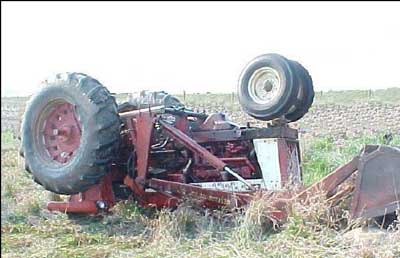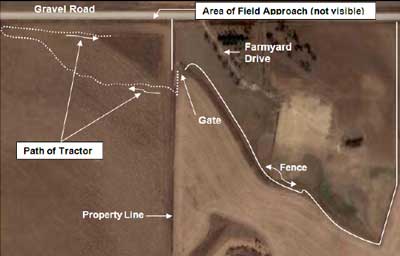Man, 29, Died when Tractor with Front-end Loader Full of Rocks Overturned
Iowa Case Report: 05IA022
Report Date: August 18 2006
Summary
Mid-spring 2005, a 29-year-old man died when the tractor he was operating overturned upside down pinning him underneath (Photo 1). The 40-year-old tractor had a narrow (tricycle) front axle. It did not have a rollover protective structure (ROPS). A front-end loader was attached to the tractor’s frame but no counter-weights had been installed for ballast. The loader with its bucket full of rocks was raised to nearly hood height. The tractor leaned to the right as the man steered it forward at a slight upward angle on a slope. The position of the heavy load, the absence of ballast, the tractor’s configuration, the dynamics of the tractor-loader combination and its load in transport on the sloping, uneven terrain contributed to the sudden overturn of this tractor. ROPS and use of the seat belt would likely have prevented this man’s death.

|
|
Photo 1 – Tractor without ROPS at scene of overturn. Note the rocks spilled from the loader bucket and height of the loader bucket relative to the tractor’s hood.
|
RECOMMENDATIONS based on our investigation are as follows:
- Agricultural tractors should be equipped with a rollover protective structure (ROPS) and the seat belt should be used, except with foldable or retractable ROPS in their down or retracted position.
- ROPS should be designed and readily available for all makes and models of agricultural tractors in common use..
- Front-end loaders should not be installed on narrow-front (“tricycle”) tractors that do not have a ROPS.
- Operators handling heavy loads should follow manufacturer recommendations for proper equipment, set up, ballasting, and safe operating practices.
Introduction
Iowa FACE personnel became aware of this tractor overturn incident through newspaper accounts two days after it occurred. A FACE case investigation was initiated and additional information was gathered from the County Sheriff and Medical Examiner. An Iowa FACE Investigator conducted an onsite interview with the victim’s parents during the summer of 2006.
Investigation
During the spring of 2005, a 29-year-old man and his spouse returned to his hometown for a weekend stay with his parents. While there they planned to do some repair work on the fence around their own 12 acre (4.9 ha) piece of land and to assist his parents with a landscaping project. The victim died when a tractor without a ROPS and its front-end loader full of rocks overturned upside down in a corn stubble field adjacent to his property.
The victim’s parent’s had a small acreage, about 7 acres (2.8 ha), at the edge of town. The son had experience farming while growing up in this rural setting. He spent summertime working on farms run by his uncles. He operated tractors and equipment while working for local farmers and in more recent jobs off the farm. Since high school he had continued his formal training, led construction projects, and performed machine design development work in the farm equipment manufacturing industry.
The tractor this man was operating when it overturned was his parent’s 90 horsepower (70 kw) tractor manufactured during the period from 1963 through 1967. His father had purchased it used from a private party the previous fall. The tractor had a narrow front axle. Its rear wheel spacing was adjusted to match standard row crop widths. A front-end loader was attached to the tractor’s frame. There was no ROPS or cab on the tractor. There was no fluid in the rear wheels, no weights added to the wheels or axles, and there was no ballast box on the rear hitch.
The young man and his wife loaded what was needed to repair the fence into the back of their sport utility vehicle (SUV). His mother had started out ahead of them on the tractor. The tractor and loader were to be used to carry rocks back from the son’s property for the landscaping project in his parent’s yard. The SUV caught up to the tractor as they arrived at the property. The victim had purchased, cleared, and fenced it before renting it to local cattlemen for income.
There was a driveway from the road into the old farmyard and a field approach into the neighbor’s property a short distance further west. The west fence line for the victim’s property ran south, perpendicular to the gravel road between the driveways, then east at a gate (Photo 2). The rocks for landscaping were in the fencerow near the gate. The neighbor’s land along the west fence and near the gate sloped toward the southwest.
The tractor was moved into position outside the gate in the farmyard fence and its loader bucket lowered to the ground. The victim loaded rocks into the bucket. Too little weight on the rear axle resulted in poor traction. The weight of the rocks and lack of counter- weight on the tractor in combination with the terrain made it difficult to move the tractor on a direct path back north toward the gravel road.

|
|
Photo 2 – Path of tractor to overturn on slope beside road in grassy, triangular area of field. Arrow indicates slope downward of area facing southwest (TerraServer).
|
The victim headed the tractor and its raised load of rocks in a northwesterly direction down and across the slope toward the road in search of another field approach at which to get onto the road. The light rear end of the tractor shifted and slipped as it crossed the ridges in the corn stubble field.
Unable to find a second field approach, he turned and headed the tractor east toward his originally-intended exit. The tractor wheels tracked between the rows that ran parallel to the road as it moved forward diagonally up the slope. The slope caused the tractor to lean a bit to the right. The victim steered it into an unfarmed area of grass, perhaps for better traction. The tractor tipped to the right pitching the operator off ahead of the overturning tractor then pinning him with his back to the ground beneath the tractor’s left rear fender.
The overturn was not witnessed. The SUV had been parked inside the farmyard, on the opposite side of the gate from where the tractor was positioned to pick up its load of rocks. The man’s mother and his wife were in the SUV exiting from the yard when they saw the rear wheels of the upside down tractor spinning in the air. They jumped out of the SUV and ran to the site. The tractor’s throttle lever was wedged against the ground and could not be moved to shut off the tractor’s engine. The ignition key was turned to the off position and the tractor engine stopped running soon afterward. They went to the nearby farm, telephoned for help, then returned to the scene.
The loader bucket was raised to where the center of its load was about the height of the tractor’s hood. This position of an uneven, heavy load in combination with sloping and changing terrain, the absence of counterweight for ballast, the configuration of the tractor (narrow front and row-crop width rear wheel spacing), and the dynamic movements of the tractor, loader, and load in transport contributed to the overturn of this tractor. ROPS with seat belt use would likely have saved this man’s life.
Cause of Death
The cause of death was compressional asphyxiation from crushing injuries to the chest.
Recommendations/Discussion
Recommendation #1 – Agricultural tractors should be equipped with a rollover protective structure (ROPS) and the seat belt should be used, except with foldable or retractable ROPS in their down or retracted position.
Discussion: ROPS are known to be highly effective in preventing deaths in overturns of tractors. Agricultural tractors offered for sale in the U.S. since 1986 have ROPS plus ROPS are commercially available from either the tractor manufacturer or from aftermarket suppliers for tractors built since 1970, and for some makes and models built before 1970. Nonetheless, about half of the tractors in productive use nationally today do not have a ROPS and seat belt installed on them (Myers and Synder, 1995). Research suggests that narrow front (tricycle) configuration, using a front-end loader, and moving over rough or sloping ground are significant risk factors in tractor overturns (Johnson and Rautiainen). The tractor in this incident was a mid-1960’s model with tricycle front axle equipped with a front-end loader being operated on a slope. While not originally marketed with ROPS, an aftermarket ROPS certified as meeting applicable standards (ASABE, 2004) can be purchased for the tractor involved in this overturn. Low clearance and orchard/vineyard uses have led to the development of foldable and retractable ROPS. Operators should follow instructions in the tractor operator’s manual regarding the use of a seat belt when their foldable or retractable ROPS is in the down or retracted position (AEM, 1990).
Recommendation #2 – ROPS should be designed and readily available for all makes and models of agricultural tractors in common use.
Many tractors like the one in this overturn incident continue to be used without ROPS. Even for tractors that are not among the most common models in current use there is often a ROPS available for a family of models that is designed and certified for it too. Efforts by manufacturers, dealers, and others regarding the importance of installing ROPS should continue to be persuasive and keep awareness of ROPS availability high.
Recommendation #3 – Front-end loaders should not be installed on narrow-front (“tricycle”) tractors that do not have a ROPS.
Discussion: Previous FACE cases have highlighted the particularly risky combination of a front-end loader mounted on a tractor that has a tricycle front axle. The popularity of tricycle front-end tractors began to decline about the time the tractor in this incident was manufactured. However, many tricycle front-end tractors are still in productive use today. They are more prone to overturns than wide front axle tractors and should not have front-end loaders or other attachments installed on them which can significantly and adversely change the center of gravity for the entire tractor-attachment combination. For example, a heavy load in a raised loader bucket shifts weight from the back wheels of the tractor to the front and at the same time raises the center of gravity of the tractor-loader combination adding to the risk of an overturn.
Recommendation #4 – Operators handling heavy loads should follow manufacturer
recommendations for proper equipment, set up, ballasting, and safe operating practices.
Discussion: Operators should be familiar with all safety messages in equipment operator manuals, safety signs on the tractor and loader, and all safe operating practices applicable to the task (AEM, 1990; NASD, 2006). It is important that the loader is matched to the tractor, that the tractor-loader combination is suitable for the load, that both are installed and adjusted according to manufacturers’ recommendations, that the combination is ballasted to counterbalance the maximum load to be lifted, and that all safe operating practices such as carrying loads low and slow are followed.
References
- AEM. 1990. Agricultural Tractor (Safety Manual)external icon. Milwaukee, WI: Association of Equipment Manufacturers. Available at https://www.aem.org.
- ASABE Standards. 2002. S355.3: Safety practices for agricultural front-end loaders. St. Joseph, MI: ASABE.
- ASABE Standards. 2004. S383.1: Roll-Over protective structures (ROPS) for wheeled agricultural tractors. St. Joseph, MI: ASABE.
- Myers JR and KA Snyder. 1995. Roll-over protective structure use and the cost of retrofitting tractors in the United States, 1993. J. of Agricultural Safety and Health. 1(3): 185-197.
- NASD. 2006. Loader Safety – Part of The Ohio State University Extension’s Agricultural Tailgate Safety Training Seriesexternal icon. Atlanta, GA: Center for Disease Control and Prevention. Available at http://www.nasdonline.org/document/1807/d001752/loader-safety.html. Accessed 09 June 2006. (Link updated 11/17/2009)
- NFMC. 1997. A guide to agricultural tractor rollover protective structures.external icon Marshfield, WI: National Farm Medicine Center. Available at http://www3.marshfieldclinic.org/NFMC//?page=nfmc_rops_guide. Accessed 18 Aug 2006. (Link updated 4/4/2013)
- TerraServerexternal icon. Available at http://www.terraserver.com/. Accessed 4 Aug 2006.
Iowa FACE Program
Fatality Assessment and Control Evaluation, FACE, is a program of the National Institute for Occupational Safety and Health (NIOSH), which is part of the Centers for Disease Control and Prevention of the U.S. Department of Health and Human Services. Nationally, the FACE program identifies traumatic deaths at work, conducts in-depth studies of select work deaths, makes recommendations for prevention, and publishes reports and alerts. The goal is to prevent occupational fatalities across the nation.
The NIOSH head office in Morgantown, West Virginia, carries out an intramural FACE case surveillance and evaluation program and also funds state-based programs in several cooperating states. In Iowa, The University of Iowa through its Injury Prevention Research Center works in conjunction with the Iowa Department of Public Health and its Office of the State Medical Examiner to conduct the Iowa FACE program.
Nationally, NIOSH combines its internal information with that from cooperating states to provide information in a variety of forms which is disseminated widely among the industries involved. NIOSH publications are available on the web at https://www.cdc.gov/NIOSH/FACE/ and from the NIOSH (1-800-CDC-INFO (1-800-232-4636) or email cdcinfo@cdc.gov).
The Iowa FACE team consists of the following from the University of Iowa: Craig Zwerling, MD, PhD, MPH, Principal Investigator; Wayne Johnson, MD, Chief Investigator; John Lundell, MA, Coordinator; Risto Rautiainen, PhD, Co-Investigator, Martin L. Jones, PhD, CIH, CSP, Co-Investigator, and John Kraemer, PA. From the Office of The State Medical Examiner.
Iowa FACE also publishes its case studies, issues precautionary messages, and prepares
articles for trade and professional publications. In addition to postings on the national NIOSH website, this information is often posted on the Iowa FACE websiteexternal icon at http://www.public-health.uiowa.edu/face/. Copies of FACE case studies and other publications are also available by contacting Iowa FACE directly.
The Iowa FACE team includes the following specialists from the University of Iowa: Craig
Zwerling, MD, PhD, MPH, Principal Investigator; John Lundell, MA, Co-Investigator; Murray Madsen, MBA, Chief Trauma Investigator; and Co-Investigator/specialists Risto Rautiainen, PhD, and Wayne Sanderson, PhD, CIH. Additional expertise is provided from the Iowa Department of Public Health, including Rita Gergely, Principal Investigator, and John Kraemer, PA, from the Office of the State Medical Examiner.
To contact Iowa State FACE program personnel regarding State-based FACE reports, please use information listed on the Contact Sheet on the NIOSH FACE web site Please contact In-house FACE program personnel regarding In-house FACE reports and to gain assistance when State-FACE program personnel cannot be reached.

